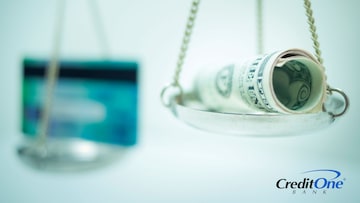Can You Pay Off One Credit Card With Another Credit Card?
October 02, 2025
Directly paying one credit card with another isn’t usually possible, but you do have workarounds. Find out the alternatives, along with their risks and benefits.

In this article:
- Introduction
- Understanding the Basics of Credit Card Payments
- What Is a Balance Transfer and How Does It Work?
- Credit Card Payment by Credit Card: Alternative Methods
- When Is It a Good Idea to Pay a Credit Card With Another Credit Card?
- Risks of Trying to Pay a Credit Card With a Credit Card
- How to Choose the Right Credit Card for a Balance Transfer
- Other Debt Management Options to Consider
- Is It Smart to Pay One Card With Another?
- Bottom Line
Introduction
If you’ve ever felt stuck juggling credit card bills, you’re not alone. Between high interest rates, unexpected expenses, and overlapping due dates, you may find yourself looking for creative solutions.
One common question that pops up when you’re feeling the pressure is, “Can you pay off one credit card with another credit card?”
And the answer isn’t a simple yes or no.
Key takeaways:
It’s usually not possible to use one credit card to pay another credit card bill.
If using another credit card is your only option, you might be able to pay through a balance transfer or cash advance.
These methods have their pros and cons.
A balance transfer often includes a low-interest promotional period, but transfer fees could negate the interest savings.
A cash advance typically comes with additional fees and higher interest rates than purchases, and may not provide a grace period before interest accrues.
Now that you’ve got the high-level overview, we’ll walk through available payment options, risks to consider, and how to determine if paying one credit card with another might make sense in your situation.
Understanding the Basics of Credit Card Payments
Most credit card issuers don’t let you directly use one credit card to pay off another. Even if you have plenty of available credit, you normally can’t just type in one credit card number to cover the minimum payment on a different one.
The credit card payment system isn’t designed to do this because simply moving debt around doesn’t effectively reduce it. Instead, most credit card companies require payments to come from a checking or savings account.
But even though you can’t typically use a credit card as a payment method for another card, you do have a couple of options that may work in a pinch. One of the most common alternatives is a balance transfer.
What Is a Balance Transfer and How Does It Work?
A balance transfer is the closest thing to paying one credit card with another. It works by moving the balance from your current card to a new one, and hopefully one offering a lower interest rate. It’s fairly common to see low- or no-interest introductory or promotional rates on credit card balance transfers — but that’s not always the case.
If you do find a good balance transfer interest rate, this move can significantly reduce the amount of interest you owe. That goes a long way toward providing some relief as you pay off the debt.
And if the receiving card has enough available credit, you could even move several higher-interest balances from other cards. That would potentially consolidate all your credit card debt into one payment.
It’s important to read the fine print, though. Balance transfer fees typically range from 2% to 5%, and you’ll want to know how long the promotional annual percentage rate (APR) period lasts. If you aren't able to pay it off in time, the interest rate will increase, which could set you back again.
Credit Card Payment by Credit Card: Alternative Methods
Let’s say a balance transfer isn’t an option. You can use a few other workarounds to pay one credit card with another, but they often come with some major drawbacks.
One option is a cash advance, which is like a short-term loan from a credit card issuer. This method could be as simple as withdrawing cash from your credit card at a bank or ATM. Then you would deposit the cash into your bank account and use that money to pay a different card, or purchase a money order or cashier’s check to pay your credit card by mail.
Speaking of paying by mail, you may periodically receive a convenience check from your creditor. You can pay whatever you like with it — including another credit card bill. But unless it’s specifically marked as a promotional balance transfer check, using that check typically works as a cash advance too.
Cash advances sound great, but they usually come with significant fees, plus a higher interest rate than normal. And that interest will typically begin immediately without a grace period. All of this makes a cash advance one of the most expensive ways to borrow money.
You could also use some third-party payment platforms to transfer money from a credit card, but many of these come with usage restrictions, fees, and risks of their own.
While you may have moments when using credit to cover a bill feels like your only option, it’s essential to weigh the tradeoffs and consider the bigger picture. For a deeper look into the complexity of paying bills with a credit card, it helps to explore how your broader budget and spending habits influence the outcome.
When Is It a Good Idea to Pay a Credit Card With Another Credit Card?
Sometimes, paying one card with another through a balance transfer makes sense. This is especially true if you’re drowning in high-interest debt and you’ve found a card that offers a long zero-interest promotional period. A transfer in this case can give you a runway to regain control, without interest charges working against you.
Situations like job loss, large medical expenses, or temporarily reduced income can all justify taking this route. In fact, just lowering your interest payments or consolidating debt can be a good reason for doing it.
Nonetheless, the strategy will work better if you have a realistic repayment plan in mind.
Risks of Trying to Pay a Credit Card With a Credit Card
Using one card to pay for another, especially outside of a balance transfer, comes with some risks you should consider.
Cash advances and third-party apps often have hidden fees and high interest rates that can quickly become overwhelming.
While you might avoid a late fee temporarily, interest charges and a rising credit utilization ratio could harm your credit score overall.
These strategies may mask more serious financial patterns like avoidance or chronic overspending.
The emotional weight of cycling through debt can create stress and impact your mental health.
If any of this feels familiar, coming to terms with being in debt can uncover the emotional and financial strain that often comes from constantly juggling balances.
How To Choose the Right Credit Card for a Balance Transfer
If you’ve decided a balance transfer is the way to go, choosing the right card matters. Look for a card that provides a 0% introductory APR for at least 12 to 18 months. This gives you enough time to pay down your balance without a bunch of interest adding up in the background.
Next, pay attention to balance transfer fees. Even a 3% fee can add up if you’re moving a large amount. Check the regular APR too, because you’ll want to avoid being surprised by a high rate once the intro period ends.
Use a comparison tool to sort through various options based on your credit profile, needs, and repayment plan. This can help you find cards that make sense for your financial situation, rather than getting caught up in flashy offers that don’t serve your goals.
Other Debt Management Options to Consider
Credit cards aren’t your only tool for managing debt. You may find that other options fit your financial goals and repayment preferences a little better.
Personal loans
Personal loans offer fixed monthly payments, which can help stabilize your finances. You can use them for debt consolidation, which reduces the number of payments you need to make each month. And they often have lower interest rates than credit cards, making them a good option if you want to reduce costs and simplify your monthly budgeting.
Debt snowball or avalanche method
The debt snowball method involves paying off your smallest balances first for momentum, while the avalanche method focuses on the highest interest debt first to minimize interest. Both strategies offer a clear sense of progress, which can help keep you motivated as you reduce your debt step by step.
Non-profit credit counseling
Non-profit credit counseling services provide professional guidance tailored to your financial situation. These organizations can help you build a personalized debt management plan while offering support in a way that’s both practical and judgment-free.
As you compare solutions, take time to browse different credit card types. Knowing what’s available can lead to better decisions and help you avoid slipping into another cycle of debt.
Is It Smart to Pay One Card With Another?
In the right circumstances, yes. Paying off one credit card with another can help you restructure your debt and reduce the interest you owe. But it’s not a catch-all solution, or a replacement for healthy financial planning and management. If you’re not careful, this move can trap you in an expensive loop of borrowing that becomes harder to escape over time — and may lead to a lower credit score.
Bottom Line
Financial decisions are personal, and the right move depends on your unique situation. If part of your struggle includes trying to rebuild credit, getting a card like the Platinum Visa for rebuilding credit may align with your goals and provide additional structure for improving your credit health.
Just remember that you don’t have to do this alone. Resources exist to help you move forward with clarity, not confusion. And every financial journey is traveled one step at a time.




